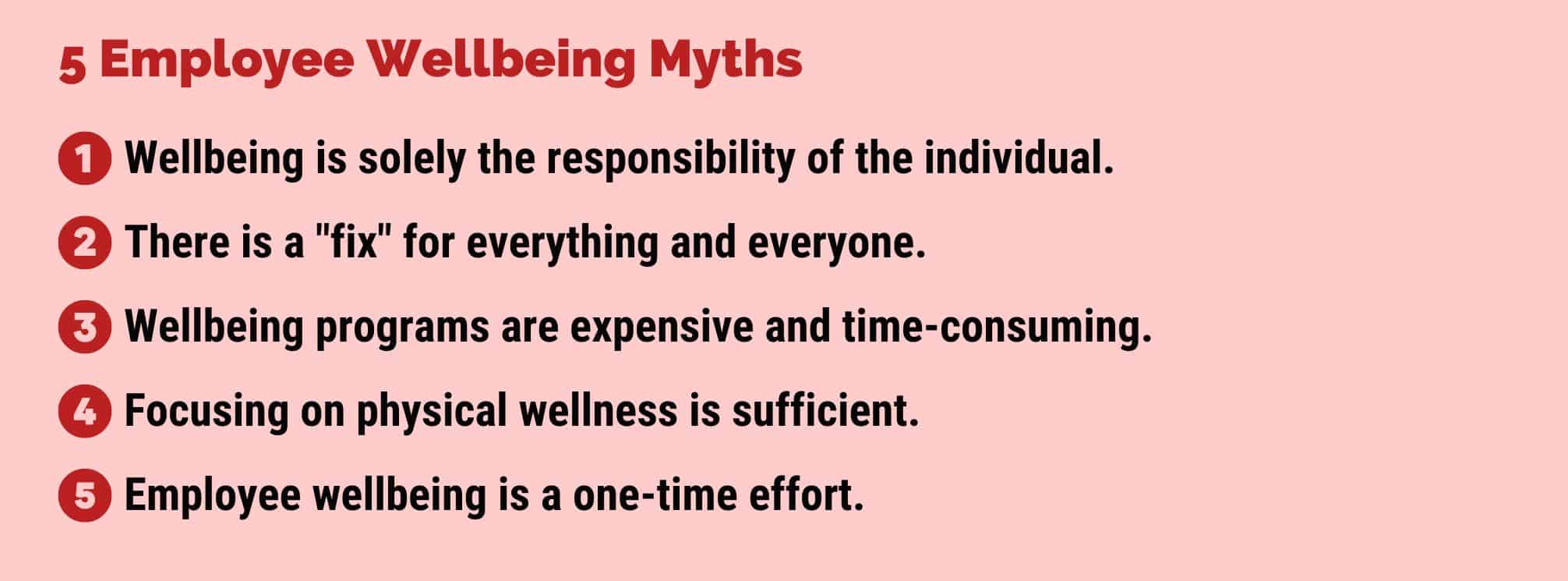Last updated on March 7, 2024 at 10:41 am
While we all can agree that employee wellbeing is important, there are a lot of myths and misconceptions about how we actually support an employee’s wellness. This can lead to us investing time and resources into programs that don’t actually work. Or don’t address mounting employee burnout and stress for the right reasons.
In this blog, we’ll shed light on how to create practical strategies that make the right kind of impact to genuinely improve employee wellbeing and create a thriving work environment.
What is Employee Wellbeing?
Employee wellbeing refers to the overall state of mental, physical, and emotional health of employees in the workplace. Often, it encompasses an employees’ quality of life, whether or not they’re thriving, and their satisfaction levels at work.
Like wellness in a more broad sense, employee wellbeing goes beyond just the absence of illness or stress. Rather, it focuses on creating an environment that supports and promotes the holistic well-being of employees.

Gallup’s 5 Elements of Employee Wellbeing
Gallup researchers have determined the five critical components of wellbeing. They are career wellbeing, social wellbeing, financial wellbeing, physical wellbeing, and community wellbeing.
Fulfillment or wellness in each of these categories add up to your overall wellbeing. Unfortunately, Gallup has found that only 7% of people are thriving in all five categories. And only 66% are doing well in at least one area. That means we have a long way to go.
What is an Example of Workplace Wellbeing?
Let’s look at an example of worker wellbeing in action. A healthy, balanced workplace that values the physical, emotional, and mental safety of their employees might look like this:
- Flexible schedules. These work environments do their best to support and encourage employees to have flexibility and choice in how and when they get work done. Although deskless employees don’t have as much flexibility in their work day, their managers can provide them flexibility and support by having adequate coverage and time off.
- Prioritizing physical health. A lot of companies offer gym stipends and stop there. But physical health is a huge topic and there are many ways to help your employees be physically healthier. This starts with the work set up. Do your frontline workers get adequate breaks? Do your hybrid and remote teams have comfortable, supportive chairs? And it extends to your mentality about employees being able to take breaks during the day to exercise, get fresh air, and actually take advantage of that gym discount or on-site facility.
- Psychological safety. One of the best ways companies can support employee mental health is by creating environments where they are safe to be themselves, speak up, and get help. But it doesn’t hurt if you offer benefits packages that include therapy and counseling.
- Robust professional development. Financial health is one of the five core components of wellbeing. Make it easier for your employees to grow in their careers by training them and promoting from within.

Why Employee Wellbeing is so Important for Business Success
When your employees thrive, your business can thrive.
If your employees are burnt out, exhausted, and on the verge of quitting due to a toxic work environment, you can’t possibly operate the way you’d like. While it’s human to have good days and bad days, it’s our job as employers to support employees and not add unnecessary stress onto our employees’ plates.
When you do make an effort to support well-being, you’ll start to see a ripple effect.
- Increased employee engagement. Employees who feel valued and supported in their overall wellbeing are more likely to be engaged in their work. They are motivated to go the extra mile, contribute their best efforts, and actively participate in achieving organizational goals.
- Higher productivity. When employees are physically and mentally healthy, they are better equipped to focus on their tasks, maintain high levels of concentration, and deliver quality work. Improved wellbeing leads to increased productivity, efficiency, and overall performance.
- Reduced absenteeism and presenteeism. Employees will be less likely to take unplanned leaves due to illness or burnout. Additionally, by fostering a supportive culture that encourages work-life balance and provides necessary resources, companies can also combat presenteeism, where employees are physically present but not fully engaged or productive.
- Improved retention. Employees who feel valued and supported are more likely to remain loyal to the company, reducing turnover rates.
- Better brand reputation. Companies that genuinely prioritize employee wellbeing establish a reputation as an employer of choice, which will attract top talent and lead to increased competitiveness in the market.
5 Things Companies Get Wrong About Employee Wellbeing
While many companies recognize the importance of employee wellbeing, there are several misconceptions that hinder our efforts to adequately support our workforce. Let’s dispel some of these myths!
1. Myth: Employee wellbeing is solely the responsibility of individuals.
Too often, programs to improve employee wellness revolve around the employee making better choices for themselves. They focus on having employees eat better, workout more, and future out how they balance work and life better. These programs don’t have the company, executive leaders, or managers take accountability for how they impact—negatively or positively—the employee experience at the organization.
2. Myth: There is a “fix” for everything and everyone.
This idea is flawed for a number of reasons. First, your employees don’t actually need “fixing.” They need support, safety, and understanding. Second, there is no one-size fits all solution when it comes to wellness. So, don’t expect your generic program to have the same impact across the board.
3. Myth: Wellbeing programs are expensive and time-consuming.
Because of the presumed cost of wellness programs, companies may try to get out of investing in a wellness program. Or worse, they try to just check the box with a free gym membership and call it a day. The sad truth is that you don’t need to invest a ton of money, necessarily, to start making an impact. Little changes and behavioral shifts from management actually can make the biggest difference when it comes to promoting an emotionally and mentally healthier workplace.
4. Myth: Focusing only on physical wellness is sufficient.
While physical health is important, employee wellbeing is much bigger than that. Not to mention, it assumes that we all need to aspire to a specific level of physical fitness to have wellbeing.
But neglecting the emotional and mental aspects of health—not to mention our levels of participation in our communities, social support, and financial wellness—can undermine overall wellbeing. Comprehensive wellbeing programs should address all dimensions of wellness.
5. Myth: Employee wellbeing is a one-time effort.
Some companies mistakenly view employee wellbeing as a one-time initiative or short-term campaign. For instance, many companies took employee burnout seriously during the pandemic. But where are those efforts now? Have they evolved with the changing needs of your employees?
Odds are, probably not. However, wellbeing should be an ongoing priority integrated into the company culture and embedded in daily practices. Sustainable wellbeing initiatives require long-term commitment and consistent support.

How Companies Can Actually Improve Workplace Wellbeing
So, how do you avoid falling for the misconceptions we just debunked? By creating a comprehensive employee wellbeing program that’s supported by employee feedback and concrete goals.
Here are three key strategies to consider.
The Role of Leadership in Promoting Employee Wellbeing
Leadership plays a crucial role in shaping the culture and values of an organization. When leaders prioritize employee wellbeing and model healthy behaviors, it sets a powerful example for the entire workforce. Here are some ways leaders can promote employee wellbeing:
- Lead by example. Leaders should prioritize their own wellbeing and demonstrate healthy work-life balance. This sends a message that employee wellbeing is valued and encouraged.
- Communicate transparently. Regularly communicate with employees about the importance of wellbeing and the support available. Transparently discuss company policies and initiatives related to wellbeing.
- Provide proper training. Equip leaders with the necessary resources and training to effectively support employee wellbeing. This can include workshops on stress management, resilience, and mental health awareness.
Creating a Supportive Work Environment
A supportive work environment is essential for fostering employee wellbeing. Not having a supportive environment at work is like building a house without a foundation. Here are some strategies to create such an environment:
- Flexible working arrangements. When possible, offer flexible work options such as remote work, flexible schedules, or compressed workweeks. This allows employees to better manage their personal and professional lives, reducing stress and enhancing wellbeing.
- Provide work-life balance. Don’t just tell employees to figure it out. Balance workloads, encourage employees to take enough time off, and create policies around overtime and respecting people’s personal time outside of work.
- Show appreciation. A thank you really goes a long way towards making people feel better about their work. Regularly acknowledge and appreciate employee contributions.
Provide Mental Health Support and Resources
Promoting mental health support is crucial for employee wellbeing. There are many resources that your company can provide. But it’s just as important to take away the stigma of asking for help, seeking counseling or therapy, and taking time off when needed.
Here are some other steps you can take.
- Offer confidential counseling services through an employee assistance program (EAP) to provide employees with professional support for various personal and work-related challenges.
- Provide resources and training on mental health awareness, stress management, and resilience-building. This helps employees better understand and address their own mental health needs.
- Establish anonymous channels for employees to seek help and support, such as a dedicated HR contact, a confidential reporting system, or access to mental health professionals.
By implementing these strategies, you can proactively improve employee wellbeing and create a positive and supportive work environment.

Investing in the Right Tools
To effectively support employee wellbeing, you need to invest in tools and technologies that empower employees and enhance communication and access to resources. Here are key considerations for selecting technology partners:
- Give employees a choice of internal comms channels.
- Make tools and information accessible—in every sense of the word. It needs to be accessible to those with disabilities, to those who work on their feet all day, to those who work different shifts, and to all roles and ages within the company.
- Updates need to be shared in real-time so employees aren’t left hanging or worrying about business updates. This includes addressing economic and global concerns head-on. For instance, if many companies in your industry are laying off workers, but you don’t plan to, make sure you tell your employees that to alleviate concerns.
Are you ready to take the next step in enhancing employee wellbeing within your organization? Request a demo of theEMPLOYEEapp today and discover how our comprehensive platform can empower your employees and elevate their wellbeing experience.
Subscribe To The theEMPLOYEEapp Newsletter
Comments are closed.




